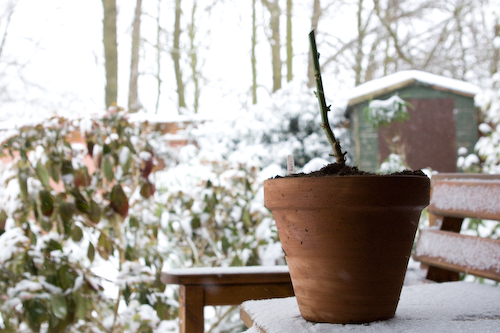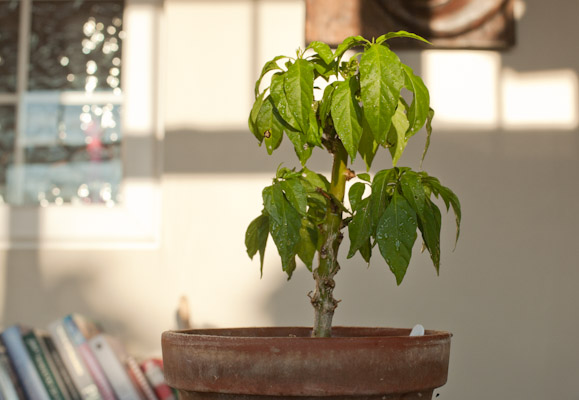Over wintering chilli plants simply describes the process of keeping your plants alive throughout the winter. Over wintering can mean your plants get a good head start to the growing season come spring.
Most people wrongly believe that chilli plants are annuals and will always die off during winter. This is wrong – with the right treatment it is easily possible to keep your chilli plants going for many years.
Seeing your pepper plants burst back into life in the spring can be very rewarding. However an added benefit is that you can expect to be picking chillies much earlier from over wintered plants.
Why over winter your chilli plants?
There are several benefits to overwintering chilli plants:
Extended Plant Lifespan: Chilli plants are perennials, meaning they can live for multiple years when cared for properly. By overwintering, you’re preserving your plants for the next growing season.
Increased Yields: Overwintered chilli plants tend to be more productive in their second year. These higher yields are a result of more established root systems that older plants will have compared to young plants.
Preserve Rare or Favorite Varieties: If you’ve grown a particular chilli variety that you love, overwintering ensures that you can enjoy the same peppers year after year without the risk of losing them to winter cold.
Earlier Harvests: If you can successfully overwinter your chilli plants they will have a massive head start over any plants you try and grow from seed in spring. The strong root structures will already be developed whih can lead to faster growth in spring and early summer. In our experance overwintered plants ted to flower and then start fruting anything from 2-4 weeks earlier than young plants. THe net result is earlier harvests from your chilli plants. This can be particularly useful for varieties such as naga or habanero that tend to ripen late in the season here in he UK.
Cure your winter boredom: Winter can be a boring time for gardeners. Overwintering peppers can provide you with some good entertainment in the dead of winter when there is little else to do in the garden.
How does over wintering chilli plants work?
Much like when and animal hibernates a plant that is overwintered acts almost the same. The plant reacts to the lower temperatures and low light levels of winter and effectively shuts down all growth phases, so much so that all signs of life disappear. For a long period of time the plant will look as if it has died. This process helps the plant protect itself from its new cold and dark environment and reduces it’s need for light and food. Once conditions improve the following spring the hibernation will reverse and the plant should sprout new growth again.
The above process is how chilli plants react in warmer climates such as Asia and South America however the colder winters we experience in Europe and North America will more often than not kill the plants. To ensure your plants survive the colder winter and come back to life next spring stronger than ever there are a few simple steps you will need to take.
When to Start Overwintering Chilli Plants?
Over the years we have found that timing is crucial when it comes to successfuly overwintering chilli plants. You should aim to start the process after your harvest is complete and before the first hard frost of the season.
The exact timing depends on your location and climate, but a general rule of thumb is to begin preparing your chilli plants for overwintering once the daytime temperatures drop consistently below around 50°F (10°C).
Ideally you want to start preperation just as the plants begin to switch to a dormancy phase. Go too soon and your plants will spring back into growth mode and use precious energy on foliage growth.
How to Overwinter Chilli Plants
1. Select healthy plants to overwinter
Not all your plants will make it though the winter. If you are anything like me, available space such as in the greenhouse or conservatory or a sunny windowsill will be limited so only choose your best looking, healthiest chilli plants to overwinter. Be sure to avoid pants with signs of pests or disease.
Of the 5 main species of chilli, pubescens tend to fare better based on my experiance over the years, however it is possible to overwinter all chilli varieties if you treat them well. As a rule it is best to over winter plants that take longer to fruit such as habaneros, naga etc as opposed to fast growing varieties like Cayenne or Japlapeno.
As summer is coming to an end give each plant a careful check over looking out for any signs of disease or pests. If you find either separate out the good plants from the bad to avoid any further infestations. Only attempt to overwinter your strongest looking plants as weaker plants will have a much lower survival rate. When night time temperatures fall (to around 10 degrees) you should start thinking about preparing your plants for the winter. In the UK this tends to be about the end of October.
Be sure to remove any chillies from your plants as you do not want to waste any! If the plants have unripe fruit then you can try and ripen them off the plant.
2. Prune Your Plants in Late Autumn
Prune back each pepper plant hard so you only leave about 15cm of the main stem. This can seem severe however it is needed to increase the plants survival chances. Remove most of the foliage leaving a few healthy leaves while taking away any dead leaves or remaining pepper pods. Only leave healthy strong branches that will be able to support new growth come spring.
With reduced foliage your chilli plant roots will not need to use much energy to survive winter. The plant can retreat into a state of dormancy until spring arrives.
3. Repotting
After trimming back your chilli plants it can be a good idea to remove them from the pot, shake off the root ball slightly and repot using some fresh compost. This will help the plant grow back healthier in the spring. If your plants are in large pots (bigger than 30cm) you can also trim back the roots slightly and pot into a smaller pot to help concentrate the energy.
Related: Take a look at our article on the best potting mix for chillies.
4. Heat & Light
Chilli plants are not particularly cold tolerant and need to be protected from frosts over winter. Overwintering your chilli plants inside a heated greenhouse will greatly increase their chances of survival. Ideally you should aim to keep your plants at around 50-60°F (10-15°C) whic is the deal range to keep them dormant.
If you dont have a heated greenhouse then an unheated conservatory works very well. Failing that try to find a sunny windowsill in a cool room in your house.
5. Watering Chilli Plants over Winter
It is crucial to avoid over watering your chilli plants durng the winter. Due to the lower temperatures, it will take much longer for them to use the water you give them. As a result water much less frequently than in the summer to avoid mould building up and the threat of root rot. Check them once a week and only water if necessary, maybe as little as every 2-3 weeks.
Without a doubt the best way to check if your plants need watering is to use a plant moisture meter. If the soil shows as dry then water a little. During winter I let the soil dry out completely between waterings.
6. Be Patient
It can often feel like you’ve kiled you plants, particuarly if they shed their leave. Be patient and trust the overwintering process! As soon as light levels and heat increase in the Spring the magic will start to happen.
When spring finally does arrive it can take a few weeks before the plants spring back into life and new growth forms. When new growth appears the plants mature root structure will enable them to grow quickly and flower/fruit long before any plants you are starting from seed that year.
Common Questions About Overwintering Chilli Plants
Can all types of chilli plants be overwintered?
Yes, most varieties of chilli plants can be overwintered successfully, including popular types like jalapeños, habaneros, and cayenne peppers. Some more sensitive varieties may require extra care, but in general, the overwintering process is the same for all chilli plants.
Do I need to prune chilli plants before overwintering?
Pruning is highly recommended before winter sets in. By reducing the amount f foliage the plants rots need to support over winter you reduce the stress on the plant during the winter months. Pruning your chilli plants also reduces the risk of pest infestations and diseases.
How long does the overwintering process last?
The overwintering process typically lasts for 3-5 months, depending on your climate. Once the outdoor temperatures rise above 50°F (10°C) consistently, you can begin reintroducing your chilli plants to the outdoors.
Will overwintering make my chilli plants produce more fruit?
Yes. As described above overwintering will increase the fruiting period of your pepper plants leading to a higher yield of fruit.
Are pepper plants perennial?
Yes. Most people incorrectly believe that chilli plants are annuals when in fat they are perennials.







